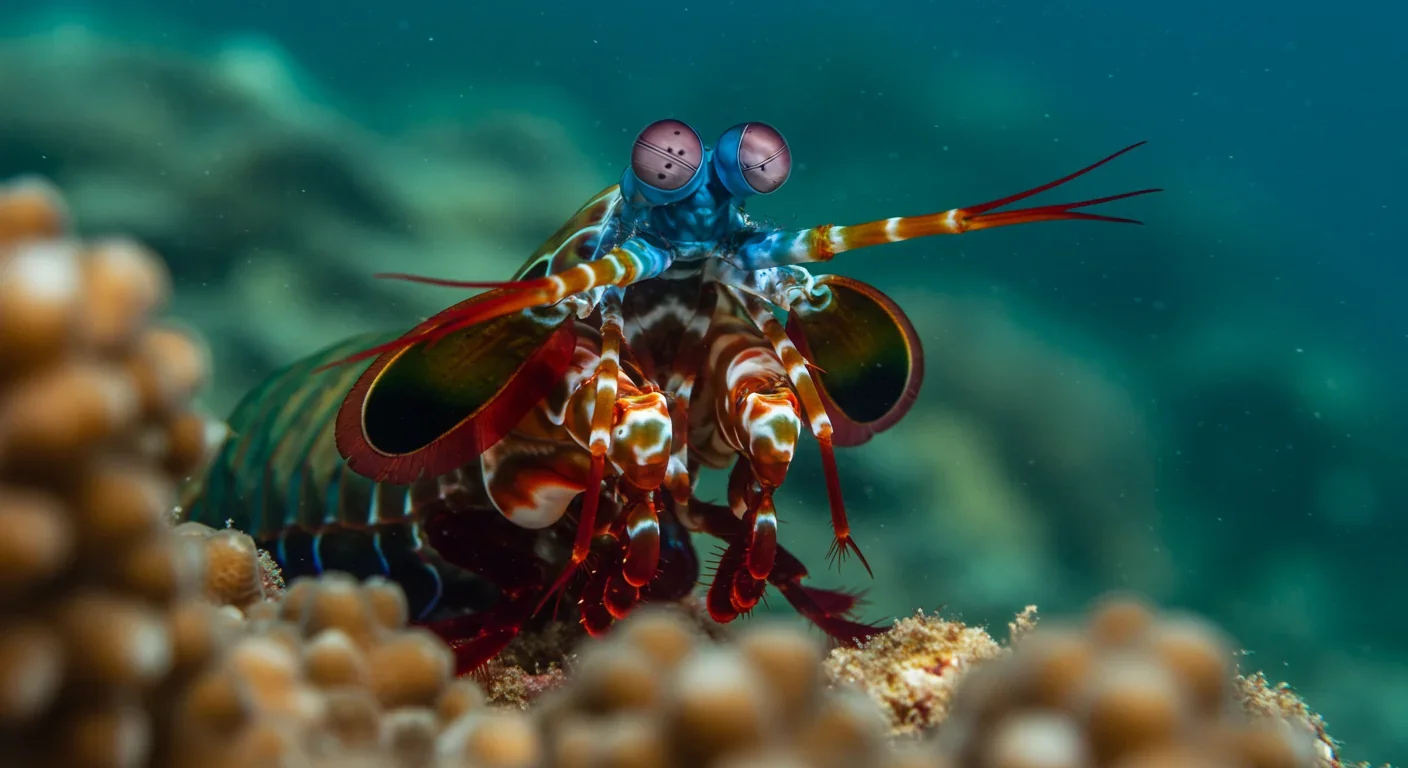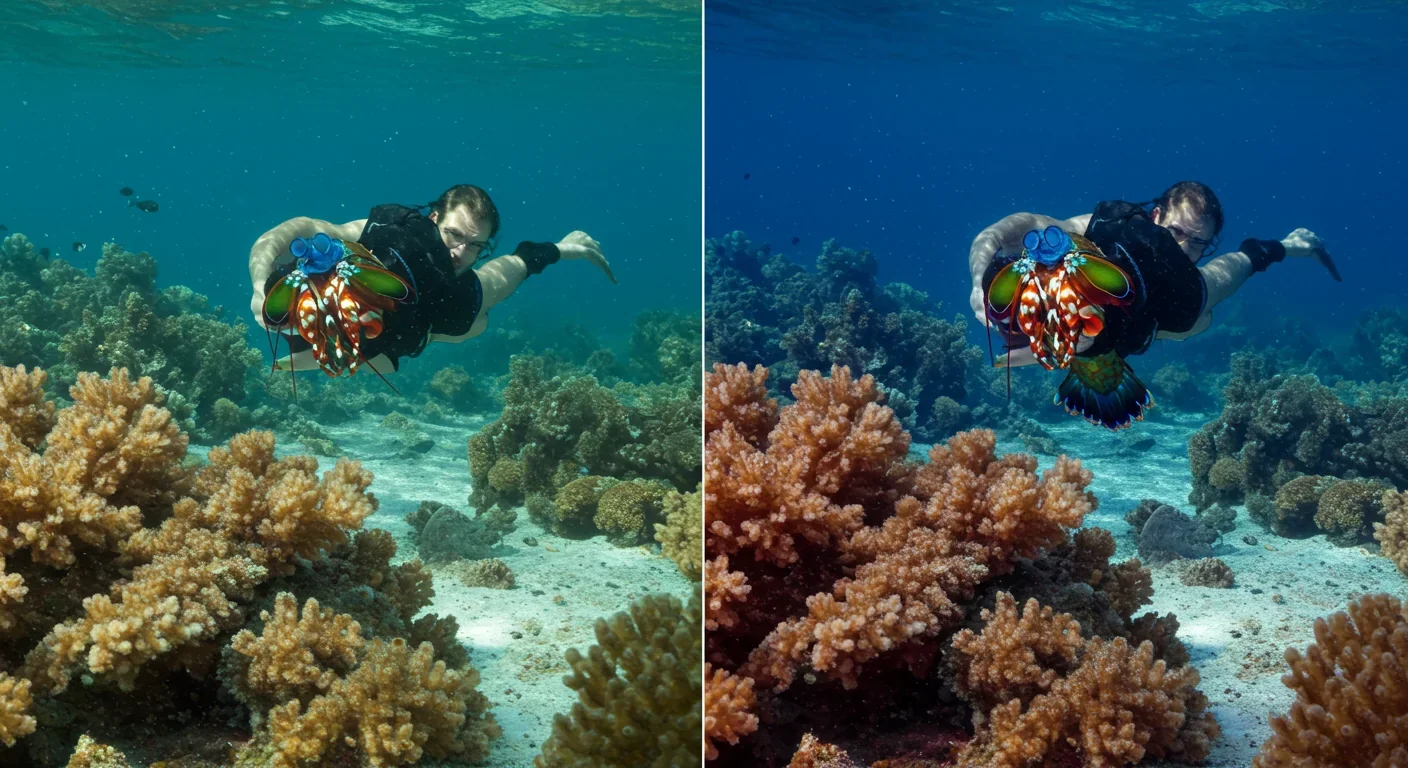Forest Biological Clocks: Ecosystems That Keep Time

TL;DR: Mantis shrimp possess up to 16 photoreceptors detecting colors and polarized light humans can't see, using a unique processing system that's inspiring next-generation imaging technology from medical diagnostics to autonomous vehicles.

By 2030, your smartphone camera might see the world the way a mantis shrimp does. These palm-sized crustaceans possess the most complex visual system known to science, detecting colors and light patterns that our eyes can't even imagine. While humans rely on three color receptors, mantis shrimp pack up to 16 photoreceptors into eyes smaller than your fingernail. Scientists are racing to decode this biological marvel because it holds the blueprint for the next generation of imaging technology.
If you've ever squinted at a sunset or marveled at a peacock's feathers, you've experienced the limits of human color vision. We see the world through red, green, and blue receptors that our brains combine into millions of hues. Mantis shrimp? They laugh at our three channels.
These marine predators possess between 12 and 16 specialized photoreceptor types, each tuned to detect different wavelengths of light. Four rows in the middle band of their compound eyes handle UV and visible light detection, while two additional rows specialize in polarized light. This isn't just overkill, it's a completely different way of processing visual information.
The most mind-bending part? Mantis shrimp are the only animals known to detect circularly polarized light, a property of light waves that most creatures (including us) are completely blind to. Imagine trying to explain color to someone who's only ever seen in black and white. That's roughly where we stand trying to comprehend what a mantis shrimp sees when it looks at a coral reef.
The mantis shrimp eye is an engineering masterpiece that would make any optical designer weep with envy. Each eye can move independently, swiveling to track prey or threats without moving their body. But here's where it gets weird: each eye is divided into three parts that focus on the same point, creating depth perception with a single eye. Most animals need two eyes for stereoscopic vision. Mantis shrimp have that capability in each eye, leaving the other free to scan for danger.
The secret lies in the midband region, a narrow strip running across each compound eye containing those rows of specialized photoreceptors. Think of it as a barcode scanner for light, constantly sampling the spectrum as the eye scans across an object. Recent behavioral experiments achieved success rates of 85% in tests where mantis shrimp distinguished colored stimuli from gray under various lighting conditions, proving they don't just have the hardware but actually use it.
What makes this system radically different from ours is the processing strategy. Humans compare signals from three color receptors through opponent processing, where our brain calculates differences between channels. Mantis shrimp appear to use a hybrid system, combining opponent processing within each row of their midband while keeping channels relatively separate, a design that reduces computational load compared to our more integrated approach.
Try to imagine a color you've never seen. You can't, because your brain has no reference for wavelengths your eyes can't detect. Mantis shrimp swim through a visual world that includes ultraviolet patterns invisible to most predators and prey.
UV vision allows them to see patterns on coral and other marine organisms that reflect ultraviolet light. Flowers use UV patterns as landing strips for pollinators; mantis shrimp likely use similar cues to identify prey species, assess the health of potential meals, or even evaluate the status of rival shrimp during territorial disputes.
Deep-sea relatives of mantis shrimp provide clues about why such extreme color vision evolved. Research on deep-sea crabs using UV and blue light sensitivity to distinguish toxic bioluminescent coral from edible plankton shows how separate color channels create a "color-coding system" for survival decisions. Mantis shrimp face similar challenges in the complex visual environment of coral reefs, where distinguishing friend from food from foe happens in milliseconds.
The polarization detection adds another dimension entirely. Polarized light reveals information about surface properties, textures, and even the internal structure of transparent animals. Some researchers suspect mantis shrimp use circularly polarized light as a secret communication channel, sending signals to potential mates that predators can't intercept. It's like having a private radio frequency that only your species can tune into.

Here's a twist: despite having one of nature's most sophisticated visual systems, mantis shrimp brains are relatively simple. They don't have massive visual processing centers like primates. So how do they make sense of all that visual information?
The answer appears to be efficiency through specialization. Instead of comparing all 12-16 color channels simultaneously (which would require enormous neural processing power), each midband row functions as a separate opponent channel. The system identifies colors quickly by recognizing which specific receptor responds most strongly, rather than computing complex ratios between multiple channels.
This explains a paradoxical finding from earlier research: despite their incredible hardware, mantis shrimp are actually worse at color discrimination tasks than humans in controlled laboratory tests. They're not trying to perceive subtle color gradients. They're built for speed, rapidly categorizing objects into predetermined color bins that trigger specific behaviors: "that's prey," "that's a mate," "that's my territory intruder."
Recent studies confirmed this with direct behavioral evidence of spectral opponency in stomatopods, showing they can differentiate between color and gray under various colored illuminations. This proves their visual system uses true color processing, not just brightness detection, but does so through a fundamentally different architecture than vertebrate vision.
Engineers studying mantis shrimp vision aren't just satisfying curiosity; they're building the next generation of imaging technology. The principles discovered in these crustaceans are already influencing hyperspectral imaging systems used in medical diagnostics, agricultural monitoring, and quality control.
Traditional cameras, like our eyes, combine three color channels into composite images. Hyperspectral cameras inspired by mantis shrimp architecture can capture dozens of narrow wavelength bands simultaneously, revealing information invisible to conventional imaging. Surgeons use these systems to visualize blood oxygenation during operations. Farmers deploy them on drones to detect plant stress before visible symptoms appear. Quality control systems spot defects in manufacturing that human inspectors would miss.
The polarization detection capability is equally valuable. Autonomous vehicles struggle with glare and transparent obstacles, problems that could be solved with mantis shrimp-inspired polarization sensors. Military applications include better camouflage detection and underwater imaging through murky water. Consumer electronics companies are exploring how polarization-sensitive cameras could improve facial recognition security and augmented reality displays.
What makes the mantis shrimp model particularly attractive is the efficiency. Rather than requiring massive computing power to process multi-channel data, their binning approach suggests ways to build fast, low-power sensors that make immediate classification decisions. This matters for edge computing applications like robots, drones, and Internet of Things devices that can't rely on cloud processing.
Male mantis shrimp perform elaborate courtship dances displaying colored patches that vary in reflectance properties across individuals. These visual displays aren't random; they're carefully calibrated signals that females evaluate when choosing mates. The extraordinary color vision of these animals likely evolved not just for hunting, but for the complex social negotiations that govern their lives.
Territorial disputes between mantis shrimp can be violent, sometimes involving their famous raptorial appendages that strike with the acceleration of a .22 caliber bullet. But before physical combat, they engage in visual assessment, sizing up opponents through color patterns that advertise size, health, and willingness to fight. Having more color channels means extracting more information from these displays, potentially avoiding costly battles through better assessment.
The polarization sensitivity may play a specialized communication role. Some mantis shrimp species have body parts that reflect circularly polarized light in ways that would be invisible to most predators but clearly visible to other mantis shrimp. It's like having bioluminescence that only your own species can see, a secret communication system operating right under the sensory noses of potential eavesdroppers.
This social dimension of color vision offers insights beyond technology. It demonstrates how sensory systems coevolve with behavior and ecology. The mantis shrimp didn't develop 16 photoreceptors just because more is better, it developed them because the specific ecological and social challenges it faces created selection pressure for rapid, reliable visual categorization across a wide spectral range.

Within the next decade, you'll likely encounter mantis shrimp-inspired technology without realizing it. Medical imaging devices already use hyperspectral principles to detect skin cancers and assess wound healing. Food safety inspectors are deploying portable devices that can spot contamination invisible to the naked eye. Smartphones may soon incorporate polarization-sensitive cameras that see through water reflections or enhance images in foggy conditions.
The technological applications extend into unexpected domains. Art historians use hyperspectral imaging to see underdrawings beneath paintings and detect forgeries. Archaeologists map ancient structures hidden under vegetation. Climate scientists monitor coral reef health by detecting stress-related changes in spectral signatures. Each application traces back to those eye-scanning shrimp that evolution turned into living spectrometers.
But here's the deeper implication: mantis shrimp vision reveals how arbitrary our own perception is. We assume the visible spectrum defines what's "real," but that's just evolutionary happenstance. Our ancestors needed to distinguish ripe fruit and read facial expressions under the savanna sun; they didn't need to see UV flower patterns or detect polarization. Different selection pressures built different visual worlds.
As virtual and augmented reality technologies advance, we're gaining the ability to visualize data outside our natural sensory range. Infrared and ultraviolet cameras can map their signals to visible colors. Polarization data can be rendered as brightness patterns. We're building technological extensions that let us peek into the mantis shrimp's rainbow, translating the unimaginable into something our limited trichromatic brains can process.
Despite decades of research, mantis shrimp vision still holds mysteries. Scientists don't fully understand how the brain integrates all those separate color channels with polarization data and motion detection. The exact neural circuitry remains largely unmapped. We know even less about how individuals develop their visual capabilities, whether different species have evolved different processing strategies, or how the system degrades with age or injury.
One fascinating question: can mantis shrimp visual capabilities be mapped to a computational model that could guide artificial sensor design? Researchers are working on this, but the hybrid opponent-binning system doesn't fit neatly into conventional computer vision frameworks. Cracking this code could lead to fundamentally new approaches to image processing.
Another mystery: how do mantis shrimp handle the challenge of chromatic adaptation? Our visual system automatically adjusts to different lighting conditions, so a white shirt looks white in both sunlight and indoor lighting. With so many independent color channels, do mantis shrimp face more complex calibration challenges? The behavioral experiments showing color discrimination under various illuminations suggest they solve this somehow, but the mechanism is unclear.
Climate change threatens coral reefs globally, and mantis shrimp along with them. As their habitats degrade, we might lose these living laboratories before we fully understand them. The species with the most spectacular vision, Gonodactylids and Lysiosquillids, are coral reef specialists particularly vulnerable to warming oceans. Preserving these ecosystems isn't just about conservation, it's about maintaining a biological library that continues to teach us new ways of seeing.
The mantis shrimp reminds us that reality is bigger than our perception of it. Somewhere in the Indo-Pacific, a peacock mantis shrimp is scanning its coral burrow with visual capabilities that would seem like superpowers to us. It sees colors we can't name, detects patterns we're blind to, and processes visual information through neural architecture we're only beginning to understand.
And yet, it's solving the same basic problems all animals face: finding food, avoiding danger, choosing mates, defending territory. The extravagant visual system it evolved to address these challenges now inspires technologies that let humans see beyond our biological limitations.
The next time you look at your phone's camera, remember that somewhere in its development history, a researcher likely studied those remarkable eyes scanning the reef. The living rainbow beneath the waves is helping us build tools that expand the human visual world, one photoreceptor at a time.
The boundary between what we can see and what exists is thinner than we think, and crustaceans the size of your thumb are showing us how to cross it.

MOND proposes gravity changes at low accelerations, explaining galaxy rotation without dark matter. While it predicts thousands of galaxies correctly, it struggles with clusters and cosmology, keeping the dark matter debate alive.

Ultrafine pollution particles smaller than 100 nanometers can bypass the blood-brain barrier through the olfactory nerve and bloodstream, depositing in brain tissue where they trigger neuroinflammation linked to dementia and neurological disorders, yet remain completely unregulated by current air quality standards.

CAES stores excess renewable energy by compressing air in underground caverns, then releases it through turbines during peak demand. New advanced adiabatic systems achieve 70%+ efficiency, making this decades-old technology suddenly competitive for long-duration grid storage.

Our brains are hardwired to see patterns in randomness, causing the gambler's fallacy—the mistaken belief that past random events influence future probabilities. This cognitive bias costs people millions in casinos, investments, and daily decisions.

Forests operate as synchronized living systems with molecular clocks that coordinate metabolism from individual cells to entire ecosystems, creating rhythmic patterns that affect global carbon cycles and climate feedback loops.

Generation Z is the first cohort to come of age amid a polycrisis - interconnected global failures spanning climate, economy, democracy, and health. This cascading reality is fundamentally reshaping how young people think, plan their lives, and organize for change.

Zero-trust security eliminates implicit network trust by requiring continuous verification of every access request. Organizations are rapidly adopting this architecture to address cloud computing, remote work, and sophisticated threats that rendered perimeter defenses obsolete.